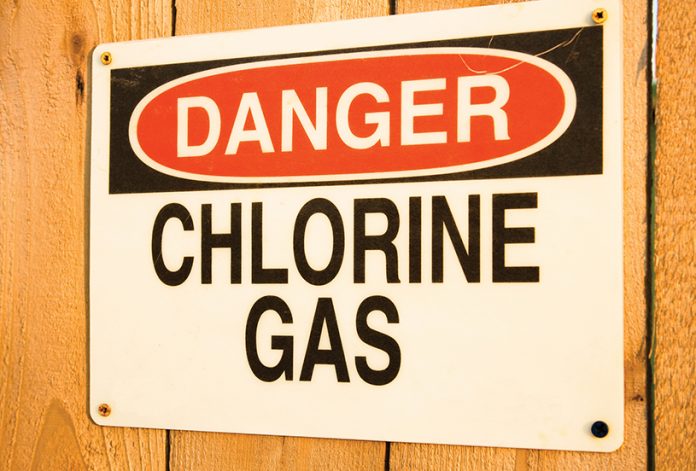An omnipresent all-rounder
Its typical odour revives childhood memories of swimming floats, headers off the 10-metre dive board and water slides, but this same odour puts an employee or safety engineer in the industry on alert. We are referring to chlorine, Cl for short.
The most prominent property of chlorine is its reactivity: it links with many elements, even at normal temperature and is frequently explosively. Chlorine is present in numerous organic and inorganic compounds, from harmless chlorides, such as sodium chloride (table salt) through to highly toxic dioxins, a chlorocarbon.
Chlorine gas itself is an everyday and fundamentally controllable risk in the Water Treatment Industry if its presence is reliably detected. But this is not that easy…
The long path to the sensor
The problem with chlorine gas is that it quickly gets caught on device surfaces, on the diaphragm of a gas detector for example, on the bump test adapter or in the valves of a calibration station, explains Ulf Ostermann, Sensor Expert at Dräger. The consequence: it simply takes much longer for the gas molecules to reach the sensor, regardless of whether a personal gas detector, clearance measurement or a functional test is used a reason for the accumulation is contamination on the devices or hoses. Anyone working in the industry knows: a mobile gas detector is never completely clean, says Ostermann. Slight to severe contamination is impossible to avoid, depending on the environment in which it is used. Deposits are formed by particles, vapours or even just the skin of the user. Chlorine molecules immediately get caught if a surface displays traces of grease. Chlorine also particularly likes to accumulate on soot particles.
Bump test cost factor
The design of test stations marketed by most manufacturers does not allow chlorine gas tests, as the path that the test gas has to travel to the sensor is too long. As a result, in many operations, the devices are exposed to gas manually. But this is error-prone, time-consuming and expensive. The molecules often get caught in the device‘s fittings, reports Ulf Ostermann. For a test gas cylinder with 5 ppm chlorine, three litres of gas first have to be pumped through so that it functions in the first place. If the test gas is then fed through additional hoses to the gassing module, the number of surfaces to which chlorine can become stuck increases even further. A tedious procedure, especially if several devices have to be tested. And, from a commercial perspective, the workload as well as the test gas consumption have a significant impact.
Wouldn‘t better cleanliness solve the problem of accumulation? This is a question that we are often asked in practice, says Ostermann. But you must not forget: we are talking about molecules. Even a device that is fastidiously wiped down with a moist cloth still displays minuscule deposits with which the chlorine molecules would react. Even the extensive use of cleaning agents does not improve the situation.
The smart solution
Countering the inertia of chlorine gas during detection with a rapid sensor is much more effective. Chlorine sensors have significant differences in their response times, the products available on the market range from 30 to 120 seconds and more. The expert Ostermann explains the practical implication of a sensor that is 4 times faster than another: sensor speed is a safety issue for safety engineers and gas analysts in a plant environment: faster response times means more time to react, more reliability when deciding on the safety precautions and, in an emergency, naturally also: fewer or less-seriously injured people and a smaller amount of damage.
Faster means safer – this equation would be emphasized for a hazardous substance such as hydrogen sulphide. Ultimately, a few seconds can be the difference between life and death in the event of exposure to H2S. But how important is the sensor speed for chlorine? Ulf Ostermann explains: H2S is obviously a special case because it is impossible to smell in dangerous concentrations. In contrast, chlorine can be directly identified by its odour in all concentrations. This means that, in the event of unexpected exposure, e.g. due to a leak, your own nose would provide a warning even if the sensor did not respond. But: the odour alone does not indicate whether a concentration is within the workplace threshold range or 20 times over this limit and this makes a significant difference after a few breaths. Let‘s not forget: this is about the health and safety of employees.




